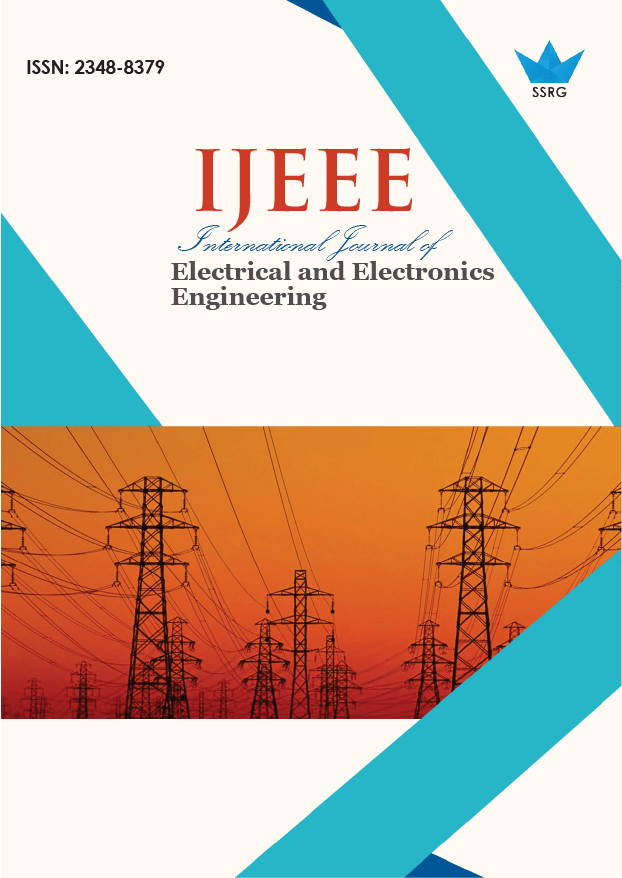INAV-Based Adaptive Transition Control for QuadPlane VTOL UAVs in Urban Wind Gust Environments

| International Journal of Electrical and Electronics Engineering |
| © 2025 by SSRG - IJEEE Journal |
| Volume 12 Issue 8 |
| Year of Publication : 2025 |
| Authors : Sujata S. Chiwande, Om Tajne, Vibhuti Katre, Hansika Mudholkar, Vaibhavi Katkule, Roshan Umate |
How to Cite?
Sujata S. Chiwande, Om Tajne, Vibhuti Katre, Hansika Mudholkar, Vaibhavi Katkule, Roshan Umate, "INAV-Based Adaptive Transition Control for QuadPlane VTOL UAVs in Urban Wind Gust Environments," SSRG International Journal of Electrical and Electronics Engineering, vol. 12, no. 8, pp. 186-195, 2025. Crossref, https://doi.org/10.14445/23488379/IJEEE-V12I8P117
Abstract:
Vertical Takeoff and Landing (VTOL) Unmanned Aerial Vehicles (UAVs) are gradually being organized for urban surveillance because of their runway independence and long-range efficiency in fixed-wing mode. The critical transition phase between hover and forward flight, compromising safety and energy efficiency, is weakened due to the changeable wind gusts in urban environments. This research paper presents an adaptive transition control algorithm for quadplane VTOL UAVs, applied on the SpeedyBee F405 Wing flight controller running INAV to dynamically regulate transition parameters (airspeed, pitch angle, and throttle) in real-time based on wind conditions. Our approach angles data from the M10 GPS, IMU, and an optional pitot tube to guess wind disturbances and optimize the transition process autonomously, contrasting conventional static transition methods. A 20% reduction in transition failures is demonstrated by field tests under gusty urban-like conditions as compared to the fixed-parameter systems, combined with an improvement of 15% in energy efficiency during surveillance missions. The System’s low-cost and open-source architecture makes it reachable for applications such as autonomous urban patrols, disaster monitoring or infrastructure inspection, where reliable VTOL operation is essential. These findings highlight the potential of adaptive algorithms to enhance the robustness of VTOL UAVs in turbulent urban airspaces, paving the way for safer and more sustainable aerial surveillance.
Keywords:
VTOL, Vertical Takeoff and Landing, Autonomous surveillance, Wind gusts, UAV, Quadplane, Drone.
References:
[1] Hazim Shakhatreh et al., “Unmanned Aerial Vehicles (UAVs): A Survey on Civil Applications and Key Research Challenges,” IEEE Access, vol. 7, pp. 48572-48634, 2019.
[CrossRef] [Google Scholar] [Publisher Link]
[2] Sarvesh Sonkar et al., “Low-Cost Smart Surveillance and Reconnaissance Using VTOL Fixed Wing UAV,” 2020 IEEE Aerospace Conference, Big Sky, MT, USA, pp. 1-7, 2020.
[CrossRef] [Google Scholar] [Publisher Link]
[3] Yue Yang et al., “Wide Area Surveillance of Urban Environments using Multiple Mini-VTOL UAVs,” IECON 2015-41st Annual Conference of the IEEE Industrial Electronics Society, Yokohama, Japan, pp. 795-800, 2015.
[CrossRef] [Google Scholar] [Publisher Link]
[4] Wen Zhao et al., “Design and Flight Simulation Verification of the Dragonfly eVTOL Aircraft,” Drones, vol. 8, no. 7, pp. 1-21, 2024.
[CrossRef] [Google Scholar] [Publisher Link]
[5] Siddhant Panigrahi, Yenugu Siva Sai Krishna, and Asokan Thondiyath, “Design, Analysis, and Testing of a Hybrid VTOL Tilt-Rotor UAV for Increased Endurance,” Sensors, vol. 21, no. 18, pp. 1-21, 2021.
[CrossRef] [Google Scholar] [Publisher Link]
[6] James F. Whidborne et al., “Effect of Rotor Tilt on the Gust Rejection Properties of Multirotor Aircraft,” Drones, vol. 6, no. 10, pp. 1-24, 2022.
[CrossRef] [Google Scholar] [Publisher Link]
[7] Hongbo Wang et al., “Aerodynamic Investigation for a Propeller-Induced Lift-Enhancing Vertical Takeoff and Landing (VTOL) Configuration,” Drones, vol. 9, no. 1, pp. 1-23, 2025.
[CrossRef] [Google Scholar] [Publisher Link]
[8] Jianan Zong et al., “Evaluation and Comparison of Hybrid Wing VTOL UAV with Four Different Electric Propulsion Systems,” Aerospace, vol. 8, no. 9, pp. 1-14, 2021.
[CrossRef] [Google Scholar] [Publisher Link]
[9] Michał Okulski, and Maciej Ławryńczuk, “A Small UAV Optimized for Efficient Long-Range and VTOL Missions: An Experimental Tan-dem-Wing Quadplane Drone,” Applied Sciences, vol. 12, no. 14, pp. 1-24, 2022.
[CrossRef] [Google Scholar] [Publisher Link]
[10] Seong-Jun Heo, and Wongi S. Na, “Review of Drone-Based Technologies for Wind Turbine Blade Inspection,” Electronics, vol. 14, no. 2, pp. 1-18, 2025.
[CrossRef] [Google Scholar] [Publisher Link]
[11] Michał Okulski, and Maciej Ławryńczuk, “A Novel Neural Network Model Applied to Modeling of a Tandem-Wing Quadplane Drone,” IEEE Access, vol. 9, pp. 14159-14178, 2021.
[CrossRef] [Google Scholar] [Publisher Link]
[12] Zairil Zaludin, and Ezanee Gires, “Automatic Flight Control Requirements for Transition Flight Phases When Converting Long Endurance Fixed Wing UAV to VTOL Aircraft,” 2019 IEEE International Conference on Automatic Control and Intelligent Systems (I2CACIS), Selangor, Malaysia, pp. 273-278, 2019.
[CrossRef] [Google Scholar] [Publisher Link]
[13] Purna Patel, and Jatinkkumar Dave, “Design and Dynamic Modeling of Quadrotor VTOL aircraft,” 2020 4th International Conference on Electronics, Communication and Aerospace Technology (ICECA), Coimbatore, India, pp. 105-112, 2020.
[CrossRef] [Google Scholar] [Publisher Link]
[14] Minh-Duc Hua et al., “A Control Approach for Thrust-Propelled Underactuated Vehicles and its Application to VTOL Drones,” IEEE Transactions on Automatic Control, vol. 54, no. 8, pp. 1837-1853, 2009.
[CrossRef] [Google Scholar] [Publisher Link]
[15] Nathaniel Simon et al., “Flow Drone: Wind Estimation and Gust Rejection on UAVs Using Fast-Response Hot-Wire Flow Sensors,” 2023 IEEE International Conference on Robotics and Automation (ICRA), London, United Kingdom, pp. 5393-5399, 2023.
[CrossRef] [Google Scholar] [Publisher Link]
[16] Mohamed Nadir Boukoberine et al., “Drone Resilient Control Against Actuator Failures and Wind Gusts,” 2022 IEEE Transportation Electrification Conference & Expo (ITEC), Anaheim, CA, USA, pp. 313-318, 2022.
[CrossRef] [Google Scholar] [Publisher Link]
[17] Jiranuwat Piriyasupakij, and Ratchada Prasitphan, “Design and Development of Autonomous Drone to Detect and Alert Intruders in Surveillance Areas,” 2023 8th International Conference on Business and Industrial Research (ICBIR), Bangkok, Thailand, pp. 1094-1099, 2023.
[CrossRef] [Google Scholar] [Publisher Link]
[18] Edward Singh et al., “Smart Agriculture Drone for Crop Spraying Using Image-Processing and Machine Learning Techniques: Experimental Validation,” Journal on Internet of Things (IoT), vol. 5, no. 2, pp. 250-270, 2024.
[CrossRef] [Google Scholar] [Publisher Link]
[19] Akshay Agarwal et al., “Impact of Super-Resolution and Human Identification in Drone Surveillance,” 2021 IEEE International Workshop on Information Forensics and Security (WIFS), Montpellier, France, pp. 1-6, 2021.
[CrossRef] [Google Scholar] [Publisher Link]

 10.14445/23488379/IJEEE-V12I8P117
10.14445/23488379/IJEEE-V12I8P117